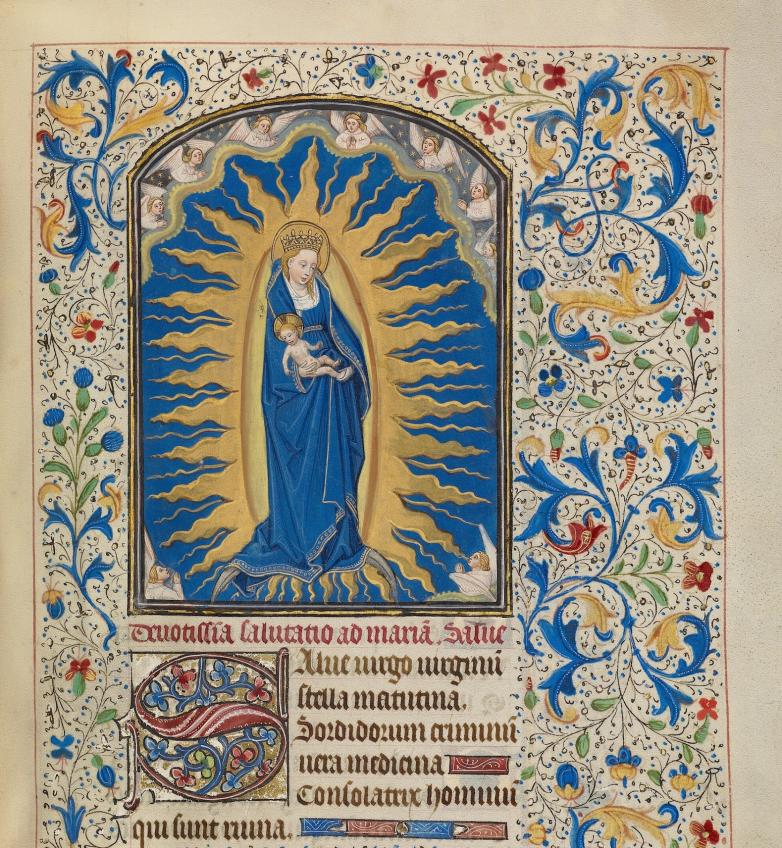Illuminated Manuscripts of the Virgin Mary Exhibition at the Getty

The Virgin and Child, early 1460s Willem Vrelant. Tempera colors, gold leaf, and ink on parchment. Ms Ludwig IX 8 (83.ML.104), fol.121
Los Angeles - The J. Paul Getty Museum presents Visualizing the Virgin Mary, featuring vibrant, illuminated manuscripts depicting stories of the Virgin Mary that attest to her role as one of the most adored figures in the Christian tradition.
Mostly drawn from the Getty’s collection, the exhibition goes on view at the Getty Center from October 11, 2022, through January 8, 2023.
"This exhibition explores the enduring devotion to, and fascination with, the Virgin Mary in the Catholic faith since the birth of Christianity and up," says Timothy Potts, Maria Hummer-Tuttle and Robert Tuttle Director of the Getty Museum. "Images of Mary, hailed as the Queen of Angels, form some of the most sacred and artistically powerful achievements of medieval art, venerated in icons and the pages of manuscripts.”
Presented in both Spanish and English, the exhibition highlights the Virgin Mary’s life, acts of miracles, and the interpretation of her image in the Middle Ages. The exhibition also explores the legacy of Marian imagery in the Americas, especially the Virgin of Guadalupe. Visualizing the Virgin Mary is the first Getty exhibition to focus on the Virgin Mary since the exhibition The Queen of the Angels over two decades ago.
“This exhibition will show how fewer than a dozen references to the Virgin in the Bible grew into a myriad of stories and images that celebrate Mary as a personal intercessor, a nursing mother, and a heavenly queen,” says Maeve O’Donnell-Morales, curator of the exhibition and former intern in the Department of Manuscripts at the Getty Museum. “The exhibition will also emphasize the role of artistic creativity in the development of Mary’s image and draws attention to the enduring visual traditions of her likeness from the Middle Ages to today.”
The exhibition’s first section, Mary Beyond the Bible, concentrates on how Mary’s biography and image were expanded in the Middle Ages, given the lack of detail used to describe Mary’s life in the Bible. Authors supplemented biblical accounts by creating narratives about her childhood, adulthood, and death. These stories were accompanied by lively and colorful images in illuminated manuscripts that record the development of Marian legend from a small number of biblical passages into the focus of widespread reverence.
Miraculous Mary focuses on the popular devotion to Mary, which increased during the course of the medieval period and continued to find expression in all forms of art —from music and manuscripts to sculpture and textiles. The stories of miracles performed by Mary and the belief in her role as intercessor for the faithful helped to secure and spread her growing importance. The exhibition features numerous images of Marian miracles and stories of personal intervention.
Mary in the Americas describes how fascination with the Virgin Mary and her image persisted long after the Middle Ages, arriving in the Americas in the 16th century with Spanish colonization. As Our Lady of Guadalupe, the Virgin Mary has been reinterpreted over the centuries, and in recent times has become an icon associated with cultural and social issues in addition to its religious role. Whether serving as divine intercessor, consoling mother, national symbol of unification, emblem of colonial oppression, or feminist role model, Mary has been reimagined by artists to create different meanings for viewers across time.
This last portion of the exhibition features three loans that honor the Virgin of Guadalupe’s significance in Hispanic and Latin cultures. Mexican artist Sebastián Salcedo's Virgén de Guadalupe, from the Denver Art Museum, is a panel from the 1700s featuring the Virgin of Guadalupe surrounded by scenes showing her miraculous appearances to Juan Diego near Mexico City in 1531. La Virgen de Guadalupe Defendiendo los Derechos de los Xicanos (The Virgin de Guadalupe Defending Xicano Rights), a 1975 self-portrait by Ester Hernández, a San Francisco-based Chicana artist, deconstructs the Virgin of Guadalupe to create a new meaning of the historic figure for contemporary women. Mexican photographer Graciela Iturbide’s La frontera, Tijuana, México, 1990, features a man facing the Tijuana border with a copy of the Virgin of Guadalupe tattooed on his back, underscoring how this well-known image of the Virgin provides comfort to those undertaking the dangerous and arduous journey to cross into the United States.
Visualizing the Virgin Mary is curated by Maeve O’Donnell-Morales, a former graduate intern at the Getty Museum, with assistance from Elizabeth Morrison, senior curator of Manuscripts at the Getty Museum.















